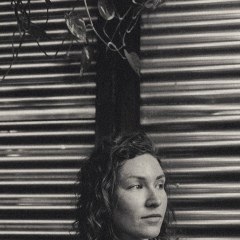«- На что это похоже?
- Как будто в твоей голове разом вещают 200 телевизионных каналов, и ты не можешь заставить замолчать ни один из них. Сотни тысяч непонятных шумов и звуков...»
Простой вопрос. Простой, но жуткий ответ. Диалог двух друзей, одному из которых поставлен диагноз «шизофрении». Через семь лет он покончит жизнь самоубийством, не найдя больше сил сопротивляться голосам демонов в своей голове. После смерти он оставит десятки треков в стиле D`n`B и навсегда войдет в историю музыки как один из основателей neurofunk. Его зовут Graham March (Desimal) и он гений.
Жизнь этого человека представляла борьбу болезни с врожденной гениальностью. Уже в 13 лет Graham мог исполнить на пианино любую композицию, услышанную им на радио. Ему легко давались любые начинания, особенно если они касались музыки. В возрасте четырнадцати лет он записывает свои первые композиции, вооружившись лишь компьютером, простенькими программами и вдохновением. Это время увлечения музыкой совершенно разных стилей: от trance до downtempo. Затем пришла страсть к D`n`B, но вплоть до 1999 года музыкант предпочитает проводить презентации своих работ исключительно перед узким кругом поклонников. Только после знакомства с известным продюсером Cyanide к Desimal начала приходить известность. Одновременно с известностью начала прогрессировать и болезнь. Эта борьба продолжалась до 2006 года. Когда побеждала гениальность, на свет появлялись композиции, которые заставили мир иначе смотреть на звучание D`n`B музыки. Болезнь победила лишь однажды…. Результатом явилась смерть Graham, и появление трека Afterlife. Записанная за два дня до самоубийства эта композиция явилась своего рода надеждой на избавление от недуга, который терзал музыканта последние годы его жизни. Desimal в разговорах с друзьями признавался, что в его сознании звучат голоса, заставляющие причинять людям боль. Для человека, никого не способного обидеть в реальной жизни, это было сущей пыткой. Может показаться мистикой, но первая часть трека действительно наполнена голосами и монологами. Они накладываются на изначально мрачное и грязноватое звучание neurofunk и рисуют крайне депрессивную картину. Наверное, так звучат дни человека, больного шизофренией. Постепенно композиция погружает вас в депрессивно-приподнятое состояние. А дальше наступает тишина, и все словно исчезает... Пропадают посторонние шумы и звуки, остается только мелодия и ритм. Приходит легкость и надежда на светлый исход. Возможно, так Desimal представлял себе жизнь после смерти. Жизнь полную свободы и покоя. Жизнь без постоянных попыток заставить эти голоса замолчать. Жизнь после жизни. Нашел он ее или нет, уже никто никогда не узнает.
- Как будто в твоей голове разом вещают 200 телевизионных каналов, и ты не можешь заставить замолчать ни один из них. Сотни тысяч непонятных шумов и звуков...»
Простой вопрос. Простой, но жуткий ответ. Диалог двух друзей, одному из которых поставлен диагноз «шизофрении». Через семь лет он покончит жизнь самоубийством, не найдя больше сил сопротивляться голосам демонов в своей голове. После смерти он оставит десятки треков в стиле D`n`B и навсегда войдет в историю музыки как один из основателей neurofunk. Его зовут Graham March (Desimal) и он гений.
Жизнь этого человека представляла борьбу болезни с врожденной гениальностью. Уже в 13 лет Graham мог исполнить на пианино любую композицию, услышанную им на радио. Ему легко давались любые начинания, особенно если они касались музыки. В возрасте четырнадцати лет он записывает свои первые композиции, вооружившись лишь компьютером, простенькими программами и вдохновением. Это время увлечения музыкой совершенно разных стилей: от trance до downtempo. Затем пришла страсть к D`n`B, но вплоть до 1999 года музыкант предпочитает проводить презентации своих работ исключительно перед узким кругом поклонников. Только после знакомства с известным продюсером Cyanide к Desimal начала приходить известность. Одновременно с известностью начала прогрессировать и болезнь. Эта борьба продолжалась до 2006 года. Когда побеждала гениальность, на свет появлялись композиции, которые заставили мир иначе смотреть на звучание D`n`B музыки. Болезнь победила лишь однажды…. Результатом явилась смерть Graham, и появление трека Afterlife. Записанная за два дня до самоубийства эта композиция явилась своего рода надеждой на избавление от недуга, который терзал музыканта последние годы его жизни. Desimal в разговорах с друзьями признавался, что в его сознании звучат голоса, заставляющие причинять людям боль. Для человека, никого не способного обидеть в реальной жизни, это было сущей пыткой. Может показаться мистикой, но первая часть трека действительно наполнена голосами и монологами. Они накладываются на изначально мрачное и грязноватое звучание neurofunk и рисуют крайне депрессивную картину. Наверное, так звучат дни человека, больного шизофренией. Постепенно композиция погружает вас в депрессивно-приподнятое состояние. А дальше наступает тишина, и все словно исчезает... Пропадают посторонние шумы и звуки, остается только мелодия и ритм. Приходит легкость и надежда на светлый исход. Возможно, так Desimal представлял себе жизнь после смерти. Жизнь полную свободы и покоя. Жизнь без постоянных попыток заставить эти голоса замолчать. Жизнь после жизни. Нашел он ее или нет, уже никто никогда не узнает.
"- What it looks like?
- It's like there are 200 television channels broadcasting in your head at once, and you can't silence any of them. Hundreds of thousands of incomprehensible noises and sounds ... "
Simple question. Simple but creepy answer. Dialogue between two friends, one of whom has been diagnosed with schizophrenia. Seven years later, he will commit suicide, finding no more strength to resist the voices of demons in his head. After his death, he will leave dozens of D'n'B tracks and will forever go down in the history of music as one of the founders of neurofunk. His name is Graham March (Desimal) and he is a genius.
This man's life represented a struggle between disease and innate genius. Already at the age of 13, Graham could play on the piano any song he heard on the radio. Any undertakings were easy for him, especially if they concerned music. At the age of fourteen, he records his first compositions, armed only with a computer, simple programs and inspiration. This is the time of passion for music of completely different styles: from trance to downtempo. Then came the passion for D`n`B, but until 1999 the musician prefers to present his works exclusively to a narrow circle of fans. It was only after meeting the renowned producer Cyanide that Desimal began to gain prominence. Simultaneously with fame, the disease began to progress. This struggle continued until 2006. When genius prevailed, compositions were born that made the world look differently at the sound of D`n`B music. The disease won only once…. The result was the death of Graham, and the emergence of the track Afterlife. Recorded two days before the suicide, this composition was a kind of hope for getting rid of the illness that tormented the musician during the last years of his life. Desimal, in conversations with friends, admitted that voices sound in his mind that make people hurt. For a person who could not offend anyone in real life, it was sheer torture. It may seem mystic, but the first part of the track is really filled with voices and monologues. They are superimposed on the initially dark and dirty neurofunk sound and paint an extremely depressing picture. Probably, this is how the days of a person with schizophrenia sound like that. Gradually, the composition plunges you into a depressive and elated state. And then there is silence, and everything seems to disappear ... Extraneous noises and sounds disappear, only the melody and rhythm remain. Lightness and hope for a bright outcome comes. Perhaps this is how Desimal envisioned life after death. Life is full of freedom and peace. A life without constantly trying to silence these voices. Life after life. Whether he found her or not, no one will ever know.
- It's like there are 200 television channels broadcasting in your head at once, and you can't silence any of them. Hundreds of thousands of incomprehensible noises and sounds ... "
Simple question. Simple but creepy answer. Dialogue between two friends, one of whom has been diagnosed with schizophrenia. Seven years later, he will commit suicide, finding no more strength to resist the voices of demons in his head. After his death, he will leave dozens of D'n'B tracks and will forever go down in the history of music as one of the founders of neurofunk. His name is Graham March (Desimal) and he is a genius.
This man's life represented a struggle between disease and innate genius. Already at the age of 13, Graham could play on the piano any song he heard on the radio. Any undertakings were easy for him, especially if they concerned music. At the age of fourteen, he records his first compositions, armed only with a computer, simple programs and inspiration. This is the time of passion for music of completely different styles: from trance to downtempo. Then came the passion for D`n`B, but until 1999 the musician prefers to present his works exclusively to a narrow circle of fans. It was only after meeting the renowned producer Cyanide that Desimal began to gain prominence. Simultaneously with fame, the disease began to progress. This struggle continued until 2006. When genius prevailed, compositions were born that made the world look differently at the sound of D`n`B music. The disease won only once…. The result was the death of Graham, and the emergence of the track Afterlife. Recorded two days before the suicide, this composition was a kind of hope for getting rid of the illness that tormented the musician during the last years of his life. Desimal, in conversations with friends, admitted that voices sound in his mind that make people hurt. For a person who could not offend anyone in real life, it was sheer torture. It may seem mystic, but the first part of the track is really filled with voices and monologues. They are superimposed on the initially dark and dirty neurofunk sound and paint an extremely depressing picture. Probably, this is how the days of a person with schizophrenia sound like that. Gradually, the composition plunges you into a depressive and elated state. And then there is silence, and everything seems to disappear ... Extraneous noises and sounds disappear, only the melody and rhythm remain. Lightness and hope for a bright outcome comes. Perhaps this is how Desimal envisioned life after death. Life is full of freedom and peace. A life without constantly trying to silence these voices. Life after life. Whether he found her or not, no one will ever know.

У записи 11 лайков,
0 репостов.
0 репостов.
Сергей Зубарев оставил(а) запись на стене пользователя Валерий Романов



























